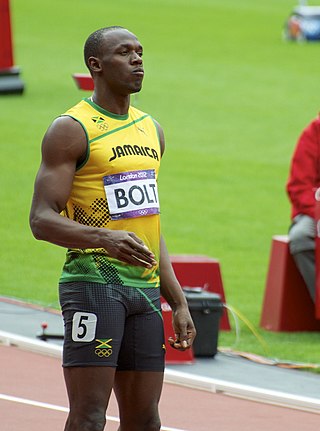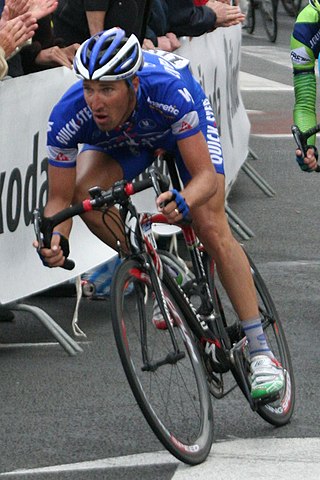
Sprinting is running over a short distance at the top-most speed of the body in a limited period of time. It is used in many sports that incorporate running, typically as a way of quickly reaching a target or goal, or avoiding or catching an opponent. Human physiology dictates that a runner's near-top speed cannot be maintained for more than 30–35 seconds due to the depletion of phosphocreatine stores in muscles, and perhaps secondarily to excessive metabolic acidosis as a result of anaerobic glycolysis.
Middle-distance running events are track races longer than sprints, up to 3000 metres. The standard middle distances are the 800 metres, 1500 metres and mile run, although the 3000 metres may also be classified as a middle-distance event. The 1500 m came about as a result of running 3+3⁄4 laps of a 400 m outdoor track or 7+1⁄2 laps of a 200 m indoor track, which were commonplace in continental Europe in the 20th century.

Aerobics is a form of physical exercise that combines rhythmic aerobic exercise with stretching and strength training routines with the goal of improving all elements of fitness. It is usually performed to music and may be practiced in a group setting led by an instructor, although it can be done solo and without musical accompaniment. With the goal of preventing illness and promoting physical fitness, practitioners perform various routines comprising a number of different dance-like exercises. Formal aerobics classes are divided into different levels of intensity and complexity and will have five components: warm-up, cardiovascular conditioning, muscular strength and conditioning, cool-down and stretching and flexibility. Aerobics classes may allow participants to select their level of participation according to their fitness level. Many gyms offer different types of aerobic classes. Each class is designed for a certain level of experience and taught by a certified instructor with a specialty area related to their particular class.

Aerobic exercise is physical exercise of low to high intensity that depends primarily on the aerobic energy-generating process. "Aerobic" is defined as "relating to, involving, or requiring oxygen", and refers to the use of oxygen to meet energy demands during exercise via aerobic metabolism adequately. Aerobic exercise is performed by repeating sequences of light-to-moderate intensity activities for extended periods of time. Examples of cardiovascular or aerobic exercise are medium- to long-distance running or jogging, swimming, cycling, stair climbing and walking.
Jack Tupper Daniels is an American exercise physiologist, running coach and a coach of Olympic athletes. On March 21, 2013, he was named the head coach of the Wells College men's and women's cross country programs. He received his doctoral degree in exercise physiology at the University of Wisconsin–Madison. Named "The World's Best Coach" by Runner's World magazine, he led SUNY Cortland runners to eight NCAA Division III National Championships, 31 individual national titles, and more than 130 All-America awards. Daniels outlined his training philosophies in the 1998 book, Daniels' Running Formula. He mentors and coaches some of America's top distance runners in the country.

Physical fitness is a state of health and well-being and, more specifically, the ability to perform aspects of sports, occupations and daily activities. Physical fitness is generally achieved through proper nutrition, moderate-vigorous physical exercise, and sufficient rest along with a formal recovery plan.
Fartlek is a middle- and long-distance runner's training approach developed in the late 1930s by Swedish Olympian Gösta Holmér. It has been described as a "relatively unscientific blending" of continuous training, with its steady pace of moderate-high intensity aerobic intensity, and interval training, with its "spacing of [more intense] exercise and rest intervals". Simply stated, in its widely adapted contemporary forms, fartlek training is alternating periods of faster and slower running, often over natural terrain, including both "level and hilly terrain".
VO2 max (also maximal oxygen consumption, maximal oxygen uptake or maximal aerobic capacity) is the maximum rate of oxygen consumption attainable during physical exertion. The name is derived from three abbreviations: "V̇" for volume (the dot appears over the V to indicate "per unit of time"), "O2" for oxygen, and "max" for maximum. A similar measure is VO2 peak (peak oxygen consumption), which is the measurable value from a session of physical exercise, be it incremental or otherwise. It could match or underestimate the actual VO2 max. Confusion between the values in older and popular fitness literature is common. The capacity of the lung to exchange oxygen and carbon dioxide is constrained by the rate of blood oxygen transport to active tissue.

Exercise intensity refers to how much energy is expended when exercising. Perceived intensity varies with each person. It has been found that intensity has an effect on what fuel the body uses and what kind of adaptations the body makes after exercise. Intensity is the amount of physical power that the body uses when performing an activity. For example, exercise intensity defines how hard the body has to work to walk a mile in 20 minutes.
Kenneth H. Cooper is a doctor of medicine and former Air Force lieutenant colonel from Oklahoma, who pioneered the benefits of doing aerobic exercise for maintaining and improving health. In 1966 he coined the term, and his book Aerobics was published in 1968, which emphasized a point system for improving the cardiovascular system. The popular mass market version was The New Aerobics (ISBN 0-553-26874-0), published ten years later.

High-intensity interval training (HIIT) is a training protocol alternating short periods of intense or explosive anaerobic exercise with brief recovery periods until the point of exhaustion. HIIT involves exercises performed in repeated quick bursts at maximum or near maximal effort with periods of rest or low activity between bouts. The very high level of intensity, the interval duration, and number of bouts distinguish it from aerobic (cardiovascular) activity, because the body significantly recruits anaerobic energy systems. The method thereby relies on "the anaerobic energy releasing system almost maximally".
The multi-stage fitness test (MSFT), also known as the beep test, bleep test, PACER (Progressive Aerobic Cardiovascular Endurance Run), PACERtest, FitnessGram PACER test, or the 20 m Shuttle Run Test (20 m SRT), is a running test used to estimate an athlete's aerobic capacity (VO2 max).
Cardiorespiratory fitness (CRF) refers to the ability of the circulatory and respiratory systems to supply oxygen to skeletal muscles during sustained physical activity. Scientists and researchers use CRF to assess the functional capacity of the respiratory and cardiovascular systems. These functions include ventilation, perfusion, gas exchange, vasodilation, and delivery of oxygen to the body's tissues. As these body's functions are vital to an individual's health, CRF allows observers to quantify an individual's morbidity and mortality risk as a function of cardiorespiratory health.
Interval training is a type of training exercise that involves a series of high-intensity workouts interspersed with rest or relief periods. The high-intensity periods are typically at or close to anaerobic exercise, while the recovery periods involve activity of lower intensity. Varying the intensity of effort exercises the heart muscle, providing a cardiovascular workout, improving aerobic capacity and permitting the person to exercise for longer and/or at more intense levels.
Long slow distance (LSD) is a form of aerobic endurance training used in sports including running, rowing, skiing and cycling. It is also known as aerobic endurance training, base training and Zone 2 training. Physiological adaptations to LSD training include improved cardiovascular function, improved thermoregulatory function, improved mitochondrial energy production, increased oxidative capacity of skeletal muscle, and increased utilization of fat for fuel. Ernst van Aaken, a German physician and coach, is generally recognized as the founder of the LSD method of endurance training.

The Army Physical Fitness Test (APFT) was designed to test the muscular strength, endurance, and cardiovascular respiratory fitness of soldiers in the United States Army. Soldiers were scored based on their performance in three events consisting of the push-up, sit-up, and a two-mile run, ranging from 0 to 100 points in each event. A minimum score of 60 in each event was required to pass the test. The soldier's overall score was the sum of the points from the three events. If a soldier passed all three events, the total could have range from 180 to 300.
A fitness boot camp is a type of group physical training program that may be conducted by gyms, personal trainers or other organizations. These programs are designed to build strength and fitness through a variety of types of exercise. The activities and format may be loosely modeled on aspects of fitness training used in the military and the trainers themselves may be former military personnel.
vV̇O2max (velocity at maximal oxygen uptake), also known as maximal aerobic speed (MAS), is an intense running or swimming pace. This is the minimum speed for which the organism's maximal oxygen uptake (VO2 max) is reached, after a few minutes of constantly maintaining this exercise intensity. At higher paces, any additional increase in power is provided by anaerobic processes. In an incremental exercise test, it is the first speed at which any increase in exercise intensity fails to elicit an increase in oxygen consumption.
Submaximal performance testing is a way of estimating either VO2 max or "aerobic fitness" in sports medicine. The test protocols do not reach the maximum of the respiratory and cardiovascular systems. Submaximal tests are used because maximal tests can be dangerous in individuals who are not considered normal healthy subjects and for elite athletes maximal tests would disrupt training load balance.
The Yo-Yointermittent test is aimed at estimating performance in stop-and-go sports like football (soccer), cricket, basketball and the like. It was conceived around the early 1990s by Jens Bangsbo, a Danish soccer physiologist, then described in a 2008 paper, "The Yo-Yo Intermittent Recovery Test". Like many other tests of fitness, it involves running at ever-increasing speeds, to exhaustion. However, a crucial difference is that the Yo-Yo Intermittent test has periodic rest intervals, thus simulating the nature of exertion in stop-and-go sports.








